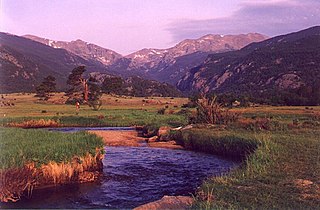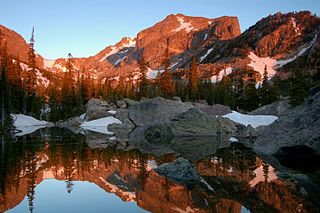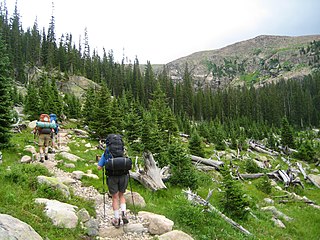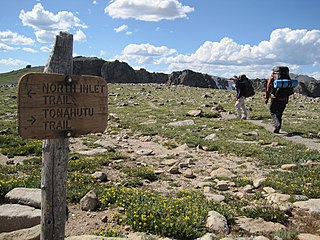
The Big Thompson River is a tributary of the South Platte River, approximately 78 miles (126 km) long, in the U.S. state of Colorado. Originating in Forest Canyon in Rocky Mountain National Park, the river flows into Lake Estes in the town of Estes Park and then through Big Thompson Canyon. It includes four crossings/bridges which are listed on the U.S. National Register of Historic Places.

Trail Ridge Road is the name for the 48-mile (77 km) stretch of U.S. Highway 34 that traverses Rocky Mountain National Park from Estes Park, Colorado in the east to Grand Lake, Colorado in the west. Together with the connecting 6.9-mile (11 km) Beaver Meadow Road, Trail Ridge Road forms the 55-mile (89 km) Trail Ridge Road/Beaver Meadow National Scenic Byway, an All-American Road. With a high point at 12,183 feet (3,713 m) elevation, Trail Ridge Road is the highest continuous paved road in North America. The higher portion of Trail Ridge Road is closed from October to May.

There are more than 1,500 properties and historic districts in the U.S. State of Colorado listed on the National Register of Historic Places. They are distributed over 63 of Colorado's 64 counties; only the City and County of Broomfield currently has none.

The Moraine Park Museum and Amphitheater, also known as the Moraine Park Lodge and the Moraine Park Visitor Center, are located in Moraine Park, a glaciated meadow between two moraines in Rocky Mountain National Park.

The Willow Park Patrol Cabin, also known as the Willow Park Ranger Station and the Willow Park Cook and Mess Hall, was built in Rocky Mountain National Park in 1923 to the design of members of the National Park Service Landscape Engineering Division under the supervision of Daniel Ray Hull. The cabin is an early example of the National Park Service Rustic style that was gaining favor with the Park Service. The cabin, along with the Willow Park Stable, originally accommodated maintenance crews on the Fall River Road.

The Fall River Pass Ranger Station in Rocky Mountain National Park was designed by National Park Service landscape architect Daniel Ray Hull in the National Park Service Rustic style. Built in 1922, the stone structure is similar in design to the Chasm Lake Shelter. Between 1933 and 1937 the ranger station was converted to a museum. The ranger station is associated with the construction of the nearby Trail Ridge Road. Located above the tree line, the building has a trap door in the roof to allow access when the door is blocked by drifting snow.

The Willow Park Stable in Rocky Mountain National Park was designed by National Park Service landscape architect Daniel Ray Hull and built in 1926. The National Park Service Rustic style stables and the nearby Willow Park Patrol Cabin were built to house crews maintaining the Fall River Road.

The Fern Lake Patrol Cabin in Rocky Mountain National Park was designed by National Park Service landscape Daniel Ray Hull and built in 1925. The National Park Service Rustic cabin was used for a time as a ranger station. It was destroyed by the East Troublesome Fire in 2020. It was listed on the National Register of Historic Places in 1988, and was delisted in 2022, after being destroyed by the East Troublesome Fire

The Snogo Snow Blower was used on the Trail Ridge Road in Rocky Mountain National Park, United States. Manufactured in 1932 by the Klauer Engineering Company of Dubuque, Iowa, the plow was actually a snowblower and featured advanced features such as an enclosed cab, four wheel drive and roll-up windows. It was used in the park until 1952.

The East Longs Peak Trail, Longs Peak Trail, Keyhole Route or Shelf Trail in Rocky Mountain National Park is listed on the National Register of Historic Places for its significance in the early recreational development of the park. The trail was laid out in 1878 by Reverend Elkanah Lamb, long before the designation of the region as parkland. It was extended in 1910 by Enos Mills. The trail leads from the Tahosa Valley, running counterclockwise around Longs Peak and reaching the summit at 14,259 feet.

The Twin Sisters Lookout, also known as the Twin Sisters Radio Tower and the Twin Sisters Shelter Cabin, was built by the U.S. Forest Service in 1914, the year before the establishment of Rocky Mountain National Park. The rustic stone structure was taken over by the National Park Service in 1925. The one-story building has an arched roof with a trap door to provide access when snow has drifted over the ground-level door. From 1914 to 1969 the shelter served as accommodations for fire observation crews at a nearby frame lookout, which has since vanished. The building is now used as a radio repeater station.

The Fall River Entrance Historic District in Rocky Mountain National Park preserves an area of park administration buildings and employee residences built in the National Park Service Rustic style. The area is close to Estes Park, Colorado, at the original primary entrance to the east side of the park. The area includes the Bighorn Ranger Station, several houses, and some utility buildings. The buildings were designed in the 1920s and 1930s by the National Park Service Branch of Plans and Designs. Many of the 1930s buildings were built by Civilian Conservation Corps labor.

Hallett Peak is a mountain summit in the northern Front Range of the Rocky Mountains of North America. The 12,720-foot (3,877 m) peak is located in the Rocky Mountain National Park Wilderness, 10.1 miles (16.2 km) southwest by west of the Town of Estes Park, Colorado, United States, on the Continental Divide between Grand and Larimer counties.

This is a list of the National Register of Historic Places listings in Larimer County, Colorado.
This is a complete list of the properties and districts on the National Register of Historic Places in Rocky Mountain National Park, Colorado, United States. The locations of National Register properties and districts for which the latitude and longitude coordinates are included below, may be seen in a map.

Midwest Steel & Iron Works was a metal fabrication company based in Denver, Colorado. Founded in 1893, the company was known for a time as the Jackson-Richter Iron Works. The company was one of the "oldest and largest metal fabricators" in Denver. The company built both structural and ornamental components for structures throughout Colorado, Wyoming, and New Mexico. The company's headquarters on Larimer Street in Denver includes an Art Deco office building and consists of a four-building complex that is itself considered a historic industrial site. The complex served as the company's headquarters from 1923 to 1983.

The North Inlet Trail, in Rocky Mountain National Park near Grand Lake, Colorado, was built up from lesser pathways and rebuilt during 1926 to 1931 into its course that mostly continues to today. The trail runs from the North Inlet feeder into Grand Lake, up 11.5 miles to Flattop Mountain. Part or all of it has also been known as Grand Lake Trail, and as Flattop Trail. A 2.8 mile spur trail called Nokoni-Nanita Spur is also included.

The Tonahutu Creek Trail, in the general area of Grand Lake, Colorado, in both Grand and Larimer counties, was listed on the National Register of Historic Places in 2008.

The Arrowhead Lodge, at 34500 Poudre Canyon Hwy., Roosevelt National Forest, in Larimer County, Colorado, served by the post office in unincorporated Bellvue, Colorado, was a resort camp which was built in 1931. It was listed on the National Register of Historic Places in 1992.




















